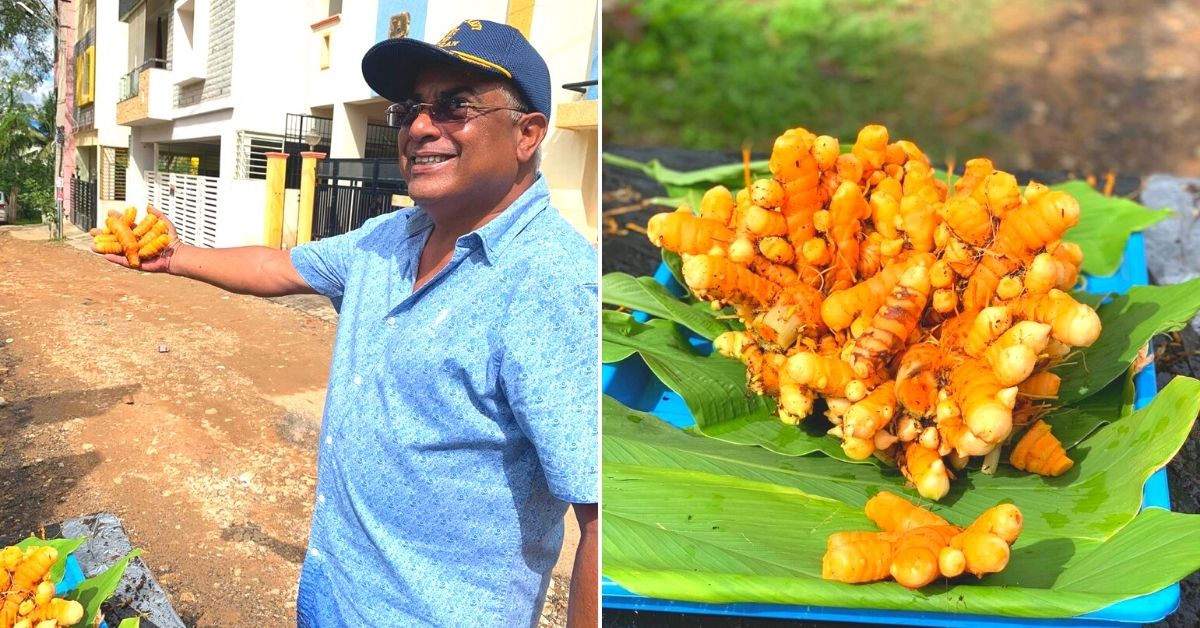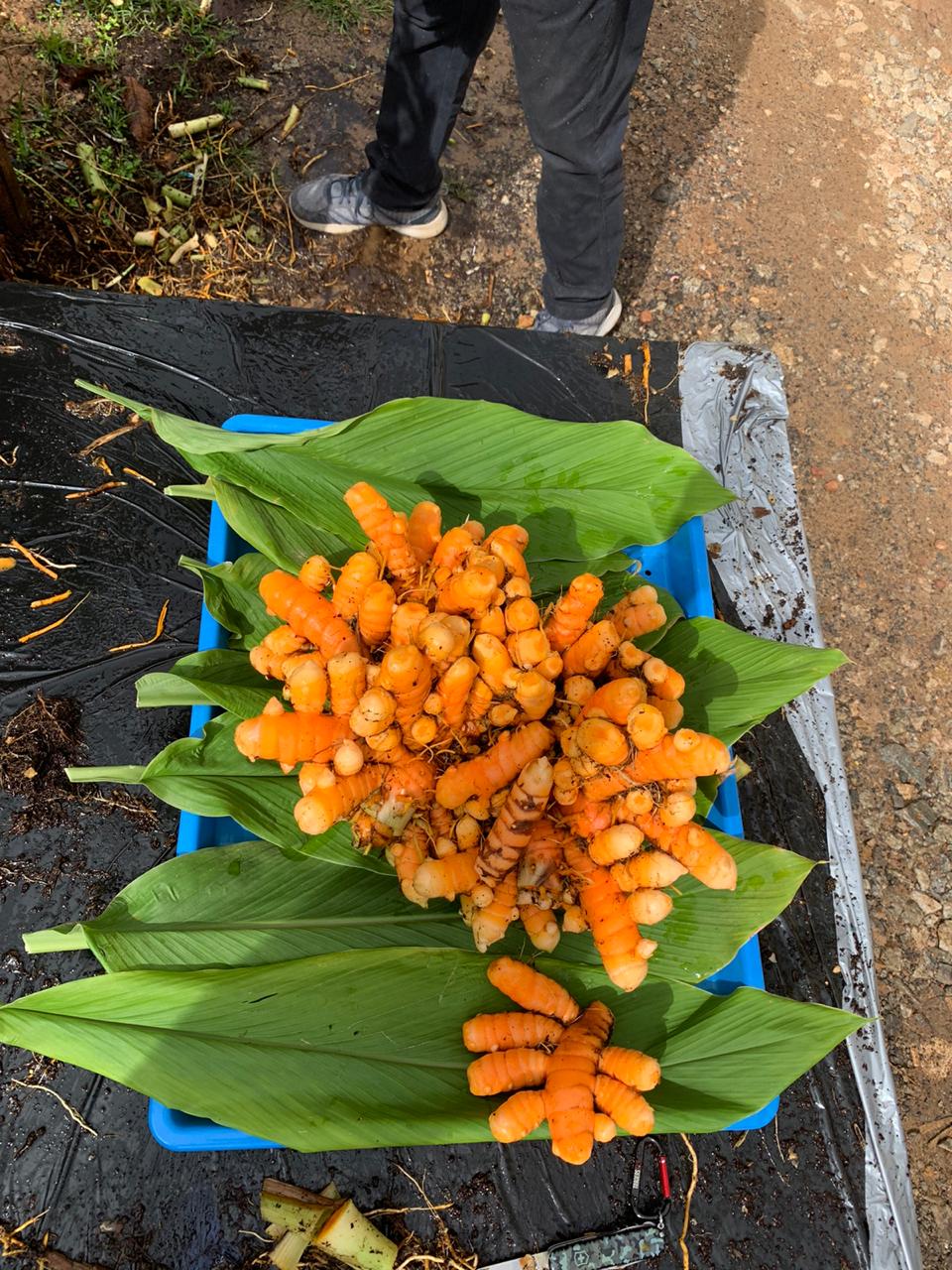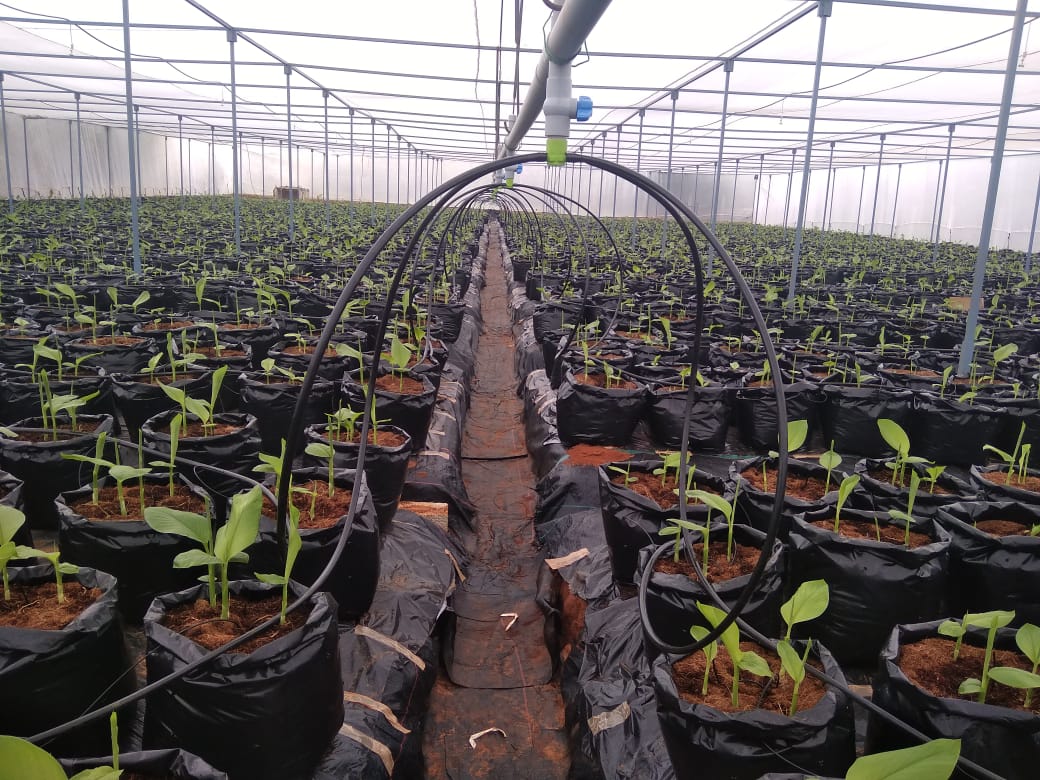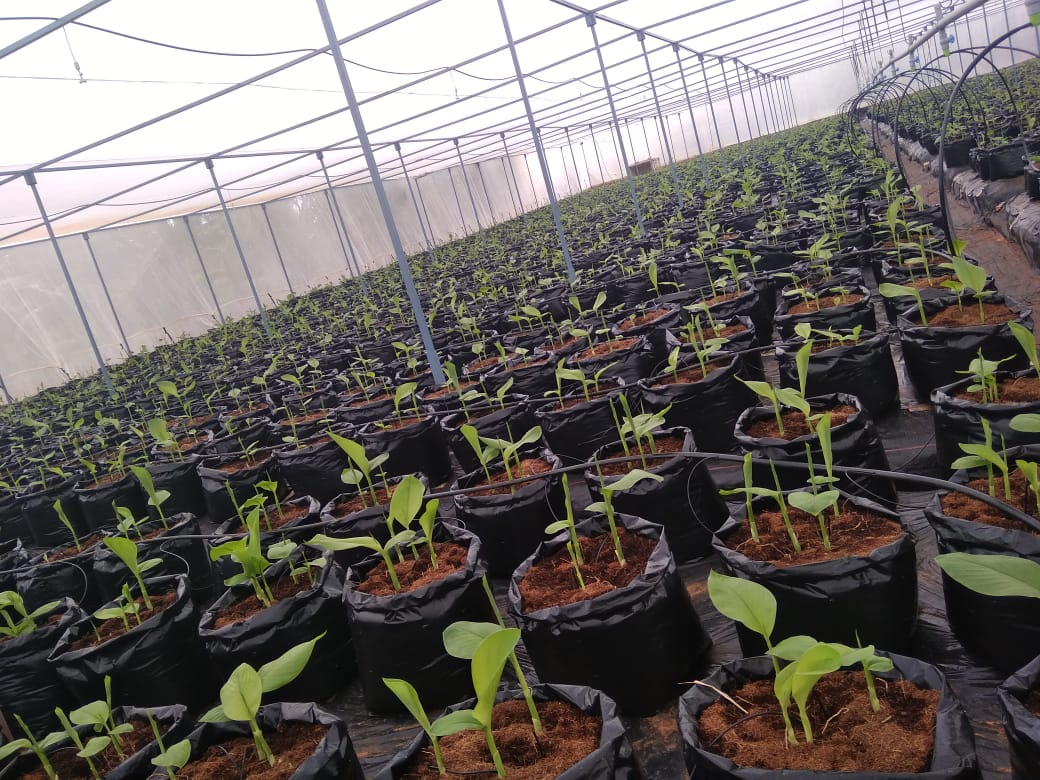Ex-Navy Man Uses Hydroponics to Start a Turmeric Revolution in Grow Bags, Gets 8 Times Higher Yield
CV Prakash, a pioneer of hydroponic farming in India who taught over 12,000 growers, has found a way to help Indian farmers grow world-class turmeric and make a splash in the international market with his Mission Turmeric 2021.

CV Prakash, a former naval officer, dedicated his free time during the lockdown last year to find ways of growing turmeric (Curcuma longa) more profitable for farmers.
He has trained over 12,000 people in soilless farming techniques (hydroponics), since 2008.
During his research into growing the Salem variety of turmeric at his CV Hydro training centre in Chikkasandra, Bengaluru, from May 2020 to January 2021, Prakash found that his specialised and unique hydroponic farming methods were generating spectacular results.
At the CV Hydro training centre under Prakash’s premier horticulture upskilling institution Aggragannya Skills, his crops generated curcumin content of 5.91%—nearly double of the standard 3% found in the Salem variety—and the highest yield was an astounding up to 8.17 kg from a single growbag.
Farmers in places like Erode, Tamil Nadu, where the Salem variety is popularly grown, only garner about 500-700 g of turmeric per plant on conventional soil farms. “At best, a farmer may get 1 kg, if he’s doing it well,” claims Prakash, speaking to The Better India.
Want to start your own hydroponics business? Join this complete A-Z guide to build your venture from start. Launched by The Better Academy, this is an end-to-end course to equip you with the knowledge required to grow crops using the popular hi-tech method of urban farming – Hydroponics.
Unable to view the above button? Click here
Beyond the curcumin content and yield, tests conducted by Eurofins Labs in Bengaluru found no traces of heavy metal since Prakash doesn’t use chemical pesticides. Also, no microbiological contamination was found, making the harvested crop a 100% saleable product from the jump.
Encouraged by the results, Prakash began Mission Turmeric 2021 in the last week of January 2021, through which he announced his “Orange revolution”. In this ‘revolution’, Prakash is teaching farmers and people from different walks of life how to cultivate this popular spice in grow bags (sizable porous bags made of high-density polyethylene) packed with coco-peat (derived from coconut fibre extracted from husks) instead of growing in soil. His turmeric crops are grown in simple net houses as turmeric is a shade-loving plant.
High Yield, Natural Method
The experiment began when Prakash’s friend sent approximately 8 kg of seed rhizomes of the Tiger Claw Salem turmeric variety grown largely in Erode last February. Prakash planted an average of 60 g seed rhizomes in each grow bag. These seed rhizomes were planted in 100 such grow bags using cocopeat instead of soil as a growing media.
Over nine months, the results Prakash got were spectacular in less than perfect conditions.
“One of the important things we considered at a base level was that turmeric is a shade lover, loves hot and humid conditions. The trials were however done in Bengaluru which has medium heat and most often dry or high VPD (Vapor Pressure Deficit) or low RH (Relative Humidity), which were not the best conditions that turmeric would want,” notes a document that Aggragannya Skills shared with The Better India.
Growing turmeric on a conventional field, Prakash claims, presents possibilities that could render nearly half the harvest waste because of pest and fungal diseases. Additionally, the turmeric crop planted by him was found to have “excellent root growth without any trace of fungal or pest infections”, notes the document. In addition, Prakash says his results are good because of his ability to monitor and control the rhizosphere/root zone.
“Most farmers who grow turmeric on conventional farms see anywhere between 40% to 50% of their harvest damaged due to rotting of rhizomes in the soil. Whatever we harvested was 100% saleable material. This naturally means that this is good for the farmer,” he claims.
How did he manage that?
“The reason was due to precision irrigation/fertigation in terms of quantity and quality, ensuring the right leaching fraction and use of beneficial microbes added before planting the seed rhizomes as well as application of the most beneficial microbes during fertigation once in 10 days or as the need may be. Application of our in-house turmeric-specific nutrients/technical grade fertilizers also played a role in the results obtained. All pest and disease problems were controlled using only biological, physical, and cultural controls and plants. No chemical pesticides were used during the entire experiment,” the document adds.
Meanwhile, analysis by Eurofins Lab found a curcumin content of 5.91%, which is significant because this bright yellow phenolic compound is known for cancer-fighting properties. There is a very strong demand for turmeric with high curcumin content from pharmaceutical companies.
“The Salem variety turmeric on soil barely gives about 2.5-3% curcumin content. This is a nine-month crop. After the sixth month, when I did a root zone analysis (which is done once a month), I found the roots were healthy and obtained a curcumin content of 5.91%. Also, there were no traces of heavy metal, which are found in chemical pesticides. Sadly, when nutraceutical and pharmaceutical companies, which extract curcumin for medicinal purposes, buy raw material from Indian farmers, it comes with a lot of heavy metal contamination due to the mindless use of chemical pesticides. Armed with these positive results in a smaller area, I set out to share my findings and make it work on the field.
After all, science in the laboratory is different from applied science on the field,” he notes.
Mission Turmeric
By the end of January 2021, Prakash launched Mission Turmeric 2021. The objective of this mission is to train people into growing world-class turmeric worthy of export. As part of this mission, he has set up 21 field growers and consults for them remotely using a cutting-edge software monitoring and evaluation platform. In addition, Prakash also has 12 people who missed the growing season on what he calls a ‘Watch and Learn’ program. These participants are informed of all the growing parameters and happenings regularly so that they can embark on commercial pilot run in the season beginning May 2022.
The first set of growers include 18 people who are growing turmeric using the soilless cultivation method on a pilot basis ranging between 500 to 1,000 square feet. These people are growing turmeric on an experimental basis, and given any success, will take the commercial route next year. Meanwhile, three of his older students are growing turmeric for commercial purposes on one acre each.
This season, Prakash is conducting R&D on eight varieties of turmeric and is looking at even better results.
These 21 growers from different parts of the country are tasked with observing and reporting 65 parameters throughout the crop cycle including leaf length and width, stem diameter, and height of the plant daily to Prakash. This is in-depth consulting where Prakash wishes to make his growers know that agriculture is a science.
One of the growers, who is part of Prakash’s ‘Orange Revolution’, is Srinivasan Ramachandran, a former vice-president with a multinational company, dealing in IT software. He quit his job about three years ago, became a freelance consultant, and began pursuing his passion in soilless cultivation.
“It was around three years ago that I went for a couple of days training in hydroponics under CV Prakash at his centre in Dharwad. Two years ago, I started a terrace farm at my Chennai residence, growing cucumbers, vegetables, and other greens. While the yield and the quality of output were good, I was unable to fetch a decent market price. The market wasn’t differentiating between my produce and vegetables grown on soil, which was disappointing because I wanted to expand operations on my farm which lies nearly 80 km from Chennai. Considering the initial investment and not-so-good returns, I put these expansion plans on hold,” says Srinivasan.
Around August-September last year, as the first lockdown was coming to an end, he visited Prakash in Bengaluru to pick his brain on what he could do to help me scale up operations.
“During the visit, Prakash told me about Mission Turmeric and showed the output he generated from his grow bags. Given its cash-rich potential, he asked me to try out turmeric on my farm. Initially, I was reluctant but decided to perform a pilot before expanding commercially. I already had a poly-house on my terrace and I converted that into a shade net. From a conversion standpoint, it did cost me around Rs 40,000. Grow bags, coco-peat, and other materials cost me around Rs 35,000 to Rs 40,000. In total, I invested about Rs 80,000 for the pilot. But if someone is building a shade net structure anew, the investment may go up to Rs 1.2 lakh,” he explains.
At present, he’s growing two varieties of turmeric—the six-month ACC Pragati and the nine-month Chenna Salem—which he sourced from AMI Traders in Pune.
“Three months into the crop cycle, it has been good from a growth standpoint based on my monthly root zone analysis. I am hoping to achieve a curcumin content of 5.91%. In terms of yields, I’m looking at around 5 kg per plant, which is on the conservative side. CV Sir said this isn’t enough and that we should work towards 10-11 kg/yield per grow bag this season,” adds Srinivasan.

Scaling Up
“In the one-acre, for a newbie, we are expecting yields of 3-3.5 kg per grow bag. It could be more since I’m downplaying these figures. To set up and operate a one-acre farm, requires an investment of about Rs 35-36 lakhs, as per our initial estimates for a crop cycle ranging 6-9 months and delivering an average yield of 80 tonnes and maximum yield of 100-120 tonnes. The initial expenses are higher than what it takes to grow turmeric on soil, but the produce and yield a farmer can obtain more than makes up for that investment,” says Prakash.
Besides, farmers can save money from the next crop cycle onwards. For example, farmers can save on buying rhizome seeds after the first crop cycle since they can generate their seeds. They can also re-use the same coco-peat for up to five years and grow bags for two or three crop cycles. Another objective of this mission is to show that farmers can grow turmeric in places where turmeric is usually not grown,
Vinaya Bhargava HN, a senior program manager at an automotive company, and his colleague Kantharaju, have set up their 1-acre farm in Tumkur, Karnataka.
“We are growing the Chennai Salem variety of turmeric. The cost of setting up and operating the farm is around Rs 35 lakh. We are projecting curcumin content of above 5% and then yield of about 5-6 kg per plant even though CV Sir would want 10 kg. I underwent a training program under CV Sir in December 2020, although by then I had already experimented with hydroponics for a couple of years prior on my terrace garden and followed his work. It has been a month since we sowed the crop,” explains Vinaya.
“Of course, one of the biggest problems for Indian farmers is finding buyers for their crops due to lack of proper market linkages and last-mile connectivity. For the purchase of quality seeds, we approached a company called AMI Seed traders from Pune, which delivers turmeric seeds of high genetic purity. They are also interested buyers of turmeric. Meanwhile, just last week, scientists from the Sami-Sabinsa Group, a major nutraceutical company, visited our R&D centre in Bengaluru and were quite impressed with how we were growing turmeric. Fortunately, at the same time, I was conducting a boot camp for my present growers. This presented an opportunity to connect my students to end buyers like them. My intervention is on the technical side of how to grow high-quality turmeric. But through Mission Turmeric 2021, I am also trying to establish end-to-end connectivity for farmers,” explains Prakash.
Besides these potential buyers, CV Hydro is also offering to help growers find buyers who pay a better price for their turmeric than conventional middlemen. These growers are offered rates ranging from Rs 18 per kg of finger wet rhizomes to Rs 100 per kg for dry polished mother rhizomes. In international markets, the miracle spice can fetch anywhere between Rs 500 to Rs 5,000 per kg depending on curcumin content and other variables.
Want to start your own hydroponics business? Join this complete A-Z guide to build your venture from start. Launched by The Better Academy, this is an end-to-end course to equip you with the knowledge required to grow crops using the popular hi-tech method of urban farming – Hydroponics.
Unable to view the above button? Click here
Before a farmer seeks Prakash’s advice or takes up the course in soilless cultivation/hydroponics, they must show commitment and dedication to the cause. After all, the former navy man considers himself ‘a Maruti 800 farmer’, who isn’t too big on using artificial intelligence to run a farm sitting inside his room. “I’m a farmer who looks to spend anywhere up to 11 hours in my greenhouse. Plants are living things that need a lot of tender love and care. That is the spirit with which you must get into this business of soilless horticulture. This is no joke,” he concludes.
(Edited by Yoshita Rao)
Like this story? Or have something to share? Write to us: [email protected], or connect with us on Facebook and Twitter.
This story made me
- 97
- 121
- 89
- 167
Tell Us More
We bring stories straight from the heart of India, to inspire millions and create a wave of impact. Our positive movement is growing bigger everyday, and we would love for you to join it.
Please contribute whatever you can, every little penny helps our team in bringing you more stories that support dreams and spread hope.



















